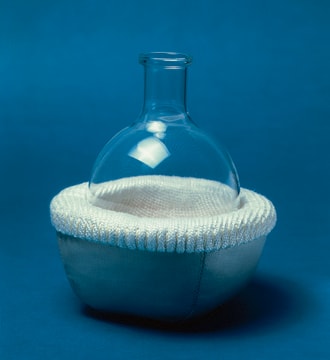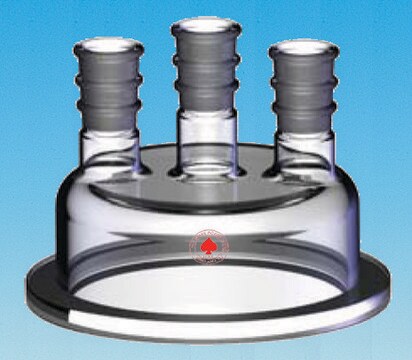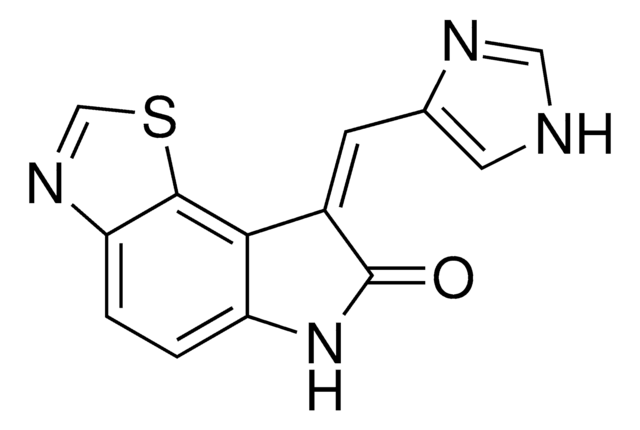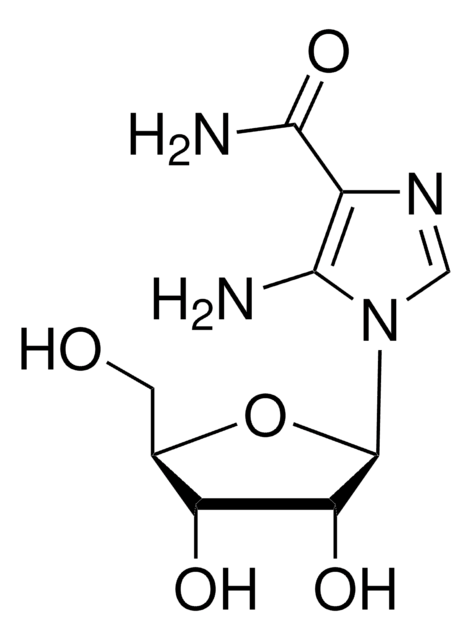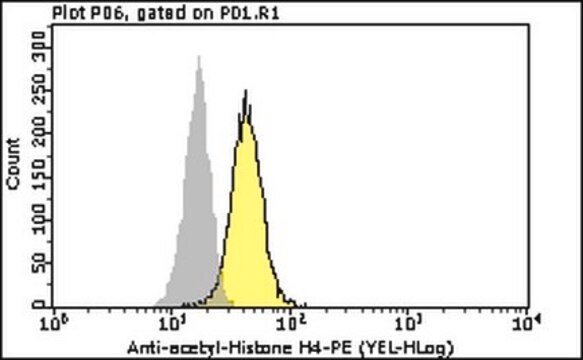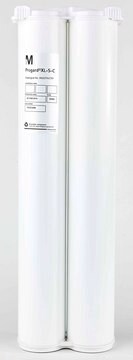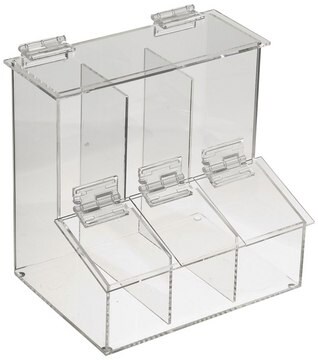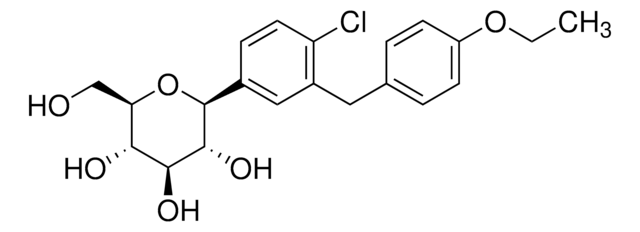17-10101
ChIPAb+ Acetylo-Histone H4 (Lys16) - przeciwciało i zestaw primerów zweryfikowane pod kątem ChIP
from rabbit
Synonim(y):
H4K16Ac, histon H4 (acetyl K16), rodzina histonów H4, członek A, histon 1, H4a, klaster histonów 1, H4a
About This Item
Polecane produkty
pochodzenie biologiczne
rabbit
Poziom jakości
forma przeciwciała
affinity purified immunoglobulin
klon
polyclonal
reaktywność gatunkowa
vertebrates, human
producent / nazwa handlowa
ChIPAb+
Upstate®
metody
ChIP: suitable
immunoprecipitation (IP): suitable
western blot: suitable
numer dostępu NCBI
numer dostępu UniProt
Warunki transportu
dry ice
Opis ogólny
Zestaw ChIPAb+ Acetylo-Histone H4 (Lys16) zawiera przeciwciało Acetylo-Histone H4 (Lys16), ujemną kontrolę normalnej króliczej IgG oraz startery qPCR, które amplifikują region 178 bp ludzkiego promotora RPL10. Acetylo-Histone H4 (Lys16) i kontrole negatywne są dostarczane w skalowalnym rozmiarze reakcji "per ChIP" i mogą być wykorzystane do funkcjonalnej walidacji wytrącania chromatyny związanej z Acetylo-Histone H4 (Lys16).
Specyficzność
Immunogen
Zastosowanie
Reprezentatywne dane partii.
Sonikowaną chromatynę przygotowaną z komórek HeLa (1 X 10E6 równoważników komórek na IP) poddano immunoprecypitacji chromatyny przy użyciu 2 µg normalnej króliczej IgG lub 2 µl anty-acetylo-histonu H4 (Lys16) i zestawu Magna ChIP A (nr kat. 17-610).
Pomyślną immunoprecypitację fragmentów DNA związanych z acetylo-Histonem H4 (Lys16) zweryfikowano za pomocą qPCR przy użyciu starterów ChIP, promotora RPL10 jako locus pozytywnego i starterów β-globiny jako locus negatywnego. (Patrz rysunki). Dane przedstawiono jako procentowy wkład każdej próbki IP w stosunku do chromatyny wejściowej dla każdego amplikonu i próbki ChIP, jak wskazano.
Szczegółowe informacje dotyczące eksperymentu można znaleźć w protokole EZ-Magna ChIP A (nr kat. 17-408) lub EZ-ChIP (nr kat. 17-371).
Analiza Western Blot:
Reprezentatywne dane partii.
Rekombinowany histon H4 (nr kat. 14-697) (lane 1) i ekstrakt kwasu HeLa (lane 2) rozdzielono metodą elektroforezy, przeniesiono na PVDF i sondowano anty-acetylowym histonem H4 (Lys16) (0,1 μg/ml).
Białka uwidoczniono przy użyciu drugorzędowego przeciwciała osła przeciw królikowi sprzężonego z HRP i systemu detekcji chemiluminescencji.
Strzałka wskazuje acetylo-histon H4 (Lys16) (~10 kDa) (patrz rysunki).
Multipleksowanie (Luminex):
Reprezentatywne dane partii.
To przeciwciało specyficznie rozpoznaje acetylowany histon H4 na Lys16 w teście Luminex (patrz rysunki).
Test inhibicji peptydowej:
Reprezentatywne dane partii.
Peptyd tego przeciwciała został zablokowany na ekstraktach komórek HeLa (patrz rysunki).
Epigenetics & Nuclear Function
Histones
Opakowanie
Jakość
Sonicated chromatin prepared from HeLa cells (1 X 10E6 cell equivalents per IP) were subjected to chromatin immunoprecipitation using either 2 µg of Normal Rabbit IgG or 2 µL of Anti-acetyl-Histone H4 (Lys16) and the Magna ChIP® A Kit (Cat. # 17-610).
Successful immunoprecipitation of acetyl-Histone H4 (Lys16) associated DNA fragments was verified by qPCR using ChIP Primers, RPL10 Promoter (Please see figures).
Please refer to the EZ-Magna ChIP A (Cat. # 17-408) or EZ-ChIP (Cat. # 17-371) protocol for experimental details.
Opis wartości docelowych
Postać fizyczna
Normalna królicza IgG. Jedna fiolka zawierająca 125 µg króliczych IgG w 125 µL buforu do przechowywania zawierającego 0,05% azydku sodu. Przechowywać w temperaturze -20°C.
Primery ChIP, promotor RPL10. Jedna fiolka zawierająca 75 μL 5 μM każdego startera specyficznego dla regionu promotora ludzkiego RPL10. Przechowywać w temperaturze -20°C.
FOR: ACC CGT CTT CGA CAG GAC T
REV: GGA ACG GAA GAC GAG AAC AG
Przechowywanie i stabilność
Komentarz do analizy
Obejmuje kontrolę ujemną, normalną króliczą IgG i startery specyficzne dla ludzkiego promotora RPL10.
Informacje prawne
Oświadczenie o zrzeczeniu się odpowiedzialności
Kod klasy składowania
12 - Non Combustible Liquids
Temperatura zapłonu (°F)
Not applicable
Temperatura zapłonu (°C)
Not applicable
Certyfikaty analizy (CoA)
Poszukaj Certyfikaty analizy (CoA), wpisując numer partii/serii produktów. Numery serii i partii można znaleźć na etykiecie produktu po słowach „seria” lub „partia”.
Masz już ten produkt?
Dokumenty związane z niedawno zakupionymi produktami zostały zamieszczone w Bibliotece dokumentów.
Nasz zespół naukowców ma doświadczenie we wszystkich obszarach badań, w tym w naukach przyrodniczych, materiałoznawstwie, syntezie chemicznej, chromatografii, analityce i wielu innych dziedzinach.
Skontaktuj się z zespołem ds. pomocy technicznej